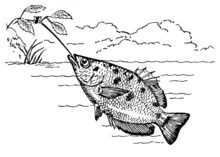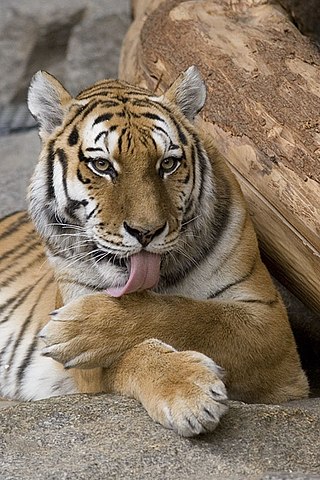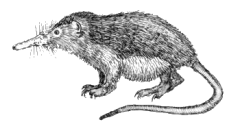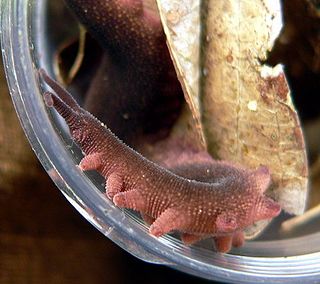
Although projectiles are commonly used in human conflict, projectile use by organisms other than humans is relatively rare.

Although projectiles are commonly used in human conflict, projectile use by organisms other than humans is relatively rare.

Most projectiles used by terrestrial animals are liquids. Among invertebrates there are a number of examples. Velvet worms can squirt out a slimy adhesive fluid from glands on the sides of their head, and use it to trap their prey. The spitting spiders Scytodes can spit a venomous sticky fluid that traps its victims and also poisons them. [1] The bombardier beetle is unusual by using a violent exothermic chemical reaction to launch a boiling noxious chemical spray in a rapid burst of pulses from special glands in its abdomen, accompanied with a popping sound. The Anthia (oogpister beetle) will fire formic acid at attackers, probably extracting the formic acid from the ants that it eats. The devil-rider stick insects ( Anisomorpha ) can fire terpenes from glands on the metathorax that can cause an intense burning irritation of the eyes and mouth of potential predators. Wood ants will spray acid at attackers. A type of planthopper of Madagascar is able to flick small balls of honeydew, this attracts day geckos that feed on the honeydew and whose presence may deter predators from approaching the sap-sucking insect. [2] Termites of the North American subfamily Nasutitermitinae can project a sticky fluid from a nozzle on their heads. They can use this fontanellar gun accurately, over a range of many centimeters, even though the termite is blind, possibly using auditory or olfactory cues instead.
A number of vertebrates also use liquid projectiles. The archerfish will squirt water from its mouth to dislodge invertebrates from overhanging branches. Some diptodactyline geckos can fire a black or pale yellow sticky fluid out of glands in their tail for a distance of about a meter, and with good aim. This fluid has a musky unpleasant odour and although it is not toxic it may discourage predators, in particular the big arthropods that prey on these geckos. [3] The spitting cobra can squirt venom from forward-facing holes in its fangs. [4] It aims for its victim's eyes, spitting up to 1.5 m. The venom may cause blindness. The Mangshan pitviper is also reported to spit venom.
A bird that uses liquid projectiles in defense is the southern giant petrel which produces a stomach oil made up of wax esters and triglycerides that are stored in the proventriculus and can be projectile vomited on predators. Other petrels such as the fulmar can also squirt oils from their mouths as a defense. They can squirt oils with accuracy up to a distance of 1 to 2 meters. The oil mats the feathers of birds together and destroys their waterproofing abilities, so oiled birds may die from chilling or drowning, although fulmars seem able to remove the oil from themselves by preening. Birds ranging from gulls to sea-eagles have died after being squirted by fulmars. [5] Some species of penguin expel liquid feces in a projectile manner, to a distance of up to about 50 cm. They are believed to do this because during the brooding season, when penguins are sitting on their nests, they avoid leaving their nests and thereby leaving their eggs open to predation and thus to maintain a clean nest they evolved the ability to project their feces. [6]
Among mammals, skunks can eject a noxious fluid from their anal glands. It is not only foul smelling, but can cause skin irritation and, if it gets in the eyes, temporary blindness. When it feels threatened a camel will bring up their stomach contents, along with saliva, and project it out towards the threat to distract, surprise, or bother the threat. [7]

Some New World tarantulas have a dense covering of hairs called urticating hairs on the abdomen that they sometimes use as protection against enemies. [8] [9] [10] Species with urticating hairs can kick these hairs off; they are flicked into the air at a target using their back pairs of legs. These fine hairs are barbed and designed to irritate and can be lethal to small animals such as rodents. The symptoms range from a burning itch to a minor rash, from being lethal to simply being a deterrent. With humans, they can cause irritation to the eyes, nose, and skin, and more dangerously, the lungs and airways, if inhaled. In some cases, tarantula hairs have caused permanent damage to human eyes.[ citation needed ] Urticating hairs do not grow back, but are replaced with each moult. Another invertebrate, the antlion, also makes use of solid projectiles. The antlion lies at the bottom of a sloping pit that it digs in the sand. Small prey slip into the pit on the loose substrate. If the prey crawls up the slopes of the pit, the antlion throws sand at the prey, which may dislodge it and send it back down the pit. [11] In gastropods, cone snails have modified radula tooth which is stored in the radular sac and at the end of proboscis, acting like a harpoon. Their "harpoon" is venomous, which assists cone snail to paralyze or kill the prey before eating it.
A number of vertebrate species also make use of solid projectiles. Among birds the hornbill uses projectile motion to eat food. The hornbill's beak typically only contacts at the tip, and it has a short tongue. To swallow food the hornbill instead throws the food from the tip of its long bill backwards into the throat. [12] One example of solid projectile use among mammals is the California ground squirrel, which is known to distract predators such as the rattlesnake and gopher snake from locating their nest burrows by kicking sand into their eyes. [13] A wild female African elephant has also been observed to throw various materials at an interfering rhino. [14] Orcas have been observed to throw seal prey using their tail flukes in apparent play behavior. [15] Some primates, including humans, can throw objects such as rocks, sticks, and feces as projectiles. Primates that are known to throw are humans, bonobos, [16] chimpanzees, [17] gorillas, [18] orangutans, [19] capuchins, [20] certain gibbons [21] and perhaps some baboons [22] and Japanese macaques [23] (although not rhesus macaques). [24] A chimpanzee named Santino in a Swedish zoo was observed to stockpile stones to be used as missiles against visitors. [25]

Chameleons, frogs and some lungless salamanders have tongues that act like a tethered projectile. In frogs, the tongue is attached at the front of the mouth and rotates about this attachment as it flips out (thus the top of the tongue at rest becomes the bottom when extended). In chameleons, the tongue contracts against a tapered hyoid bone, eventually slipping off and projecting forward at very high speed. Lungless salamanders use a similar method, however, both the tongue and underlying hyoid bone project (in contrast to chameleons, whose hyoid remains fixed while the fleshy portion of the tongue projects). [26] In both salamanders and chameleons, the movement is too fast and requires too much mechanical power for muscle alone to provide – instead, muscles slowly pre-load elastic elements such as connective tissue, which can then recoil and release the stored energy at a much higher rate. [27] [28] In order to retract their tongues over such great distances, the tongue muscles of chameleons have perforated Z-disks, allowing each sarcomere to shorten far greater distances than those of other vertebrates. [29]
The pistol shrimp claw has a pistol-like feature made of two parts. A joint allows the "hammer" part to move backward into a right-angled position. When released, it snaps into the other part of the claw, emitting an enormously powerful wave of bubbles capable of stunning larger fish and breaking glass. [30]
The seed pods of the orange jewelweed have projectile seeds that, if ripe, explode out of the pods when they are lightly touched. The seed pods of the scotch broom also burst open, often with an audible crack, projecting the seeds from the parent plant. Similarly, the fruit of the sandbox tree burst open to disperse seeds, but the reaction is so violent that it can injure nearby people or livestock. [31] Some plants such as the dogwood bunchberry and white mulberry will also fling pollen from their flowers. Peat mosses are known to explosively launch their spores. [32]
Hat-throwing fungi fire their spore capsules up to 2 m, [33] and the cannonball fungi of the genus Sphaerobolus , such as S. stellatus, the artillery fungus can throw sticky spore sacs up to 6 m horizontally. [34] [35] This species is phototropic, and propels spores towards the nearest source of direct or reflected light, like the sides of brightly colored houses. [36]

The chimpanzee, also known as simply the chimp, is a species of great ape native to the forests and savannahs of tropical Africa. It has four confirmed subspecies and a fifth proposed one. When its close relative the bonobo was more commonly known as the pygmy chimpanzee, this species was often called the common chimpanzee or the robust chimpanzee. The chimpanzee and the bonobo are the only species in the genus Pan. Evidence from fossils and DNA sequencing shows that Pan is a sister taxon to the human lineage and is humans' closest living relative. The chimpanzee is covered in coarse black hair, but has a bare face, fingers, toes, palms of the hands, and soles of the feet. It is larger and more robust than the bonobo, weighing 40–70 kg (88–154 lb) for males and 27–50 kg (60–110 lb) for females and standing 150 cm.

Lizards are a widespread group of squamate reptiles, with over 7,000 species, ranging across all continents except Antarctica, as well as most oceanic island chains. The group is paraphyletic since it excludes the snakes and Amphisbaenia, and some lizards are more closely related to these two excluded groups than they are to other lizards. Lizards range in size from chameleons and geckos a few centimeters long to the 3-meter-long Komodo dragon.

Salamanders are a group of amphibians typically characterized by their lizard-like appearance, with slender bodies, blunt snouts, short limbs projecting at right angles to the body, and the presence of a tail in both larvae and adults. All ten extant salamander families are grouped together under the order Urodela from the group Caudata. Salamander diversity is highest in eastern North America, especially in the Appalachian Mountains; most species are found in the Holarctic realm, with some species present in the Neotropical realm.

Female ejaculation is characterized as an expulsion of fluid from the Skene's gland at the lower end of the urethra during or before an orgasm. It is also known colloquially as squirting, although research indicates that female ejaculation and squirting are different phenomena, squirting being attributed to a sudden expulsion of liquid that partly comes from the bladder and contains urine.

The archerfish or Toxotidae are a monotypic family of perciform tropical fish known for their unique predation technique of "shooting down" land-based insects and other small prey with jets of water spit from their specialized mouths. The family is small, consisting of ten species in a single genus, Toxotes. Most archerfish live in freshwater streams, ponds and wetlands, but two or three species are euryhaline, inhabiting both fresh and brackish water habitats such as estuaries and mangroves. They can be found from India, Bangladesh and Sri Lanka, through Southeast Asia, to Melanesia and Northern Australia.

Urticating hairs or urticating bristles are one of the primary defense mechanisms used by numerous plants, almost all New World tarantulas, and various lepidopteran caterpillars. Urtica is Latin for "nettle", and bristles that urticate are characteristic of this type of plant, and many other plants in several families. This term also refers to certain types of barbed bristles that cover the dorsal and posterior surface of a tarantula's or caterpillar's abdomen. Many tarantula species eject bristles from their abdomens, directing them toward potential attackers. These bristles can embed themselves in the other animal's skin or eyes, causing physical irritation, usually to great discomfort. The term "hairs" is technically a misnomer, as technically only mammals possess true hairs. The technical word for plant hairs is trichomes.

Licking is the action of passing the tongue over a surface, typically either to deposit saliva onto the surface, or to collect liquid, food or minerals onto the tongue for ingestion, or to communicate with other animals. Many animals both groom themselves, eat or drink by licking.

The Chilean rose tarantula, also known as the rose hair tarantula, the Chilean fire tarantula, or the Chilean red-haired tarantula, is probably the most common species of tarantula available in American and European pet stores today, due to the large number of wild-caught specimens exported cheaply from their native Chile into the pet trade. The species is also known from Bolivia and Argentina.

The antlions are a group of about 2,000 species of insect in the neuropteran family Myrmeleontidae. They are known for the predatory habits of their larvae, which mostly dig pits to trap passing ants or other prey. In North America, the larvae are sometimes referred to as doodlebugs because of the marks they leave in the sand. The adult insects are less well known due to their relatively short lifespans compared to the larvae. Adults, sometimes known as antlion lacewings, mostly fly at dusk or just after dark and may be mistakenly identified as dragonflies or damselflies.

Anti-predator adaptations are mechanisms developed through evolution that assist prey organisms in their constant struggle against predators. Throughout the animal kingdom, adaptations have evolved for every stage of this struggle, namely by avoiding detection, warding off attack, fighting back, or escaping when caught.

Venomous mammals are animals of the class Mammalia that produce venom, which they use to kill or disable prey, to defend themselves from predators or conspecifics or in agonistic encounters. Mammalian venoms form a heterogeneous group with different compositions and modes of action, from three orders of mammals: Eulipotyphla, Monotremata, and Chiroptera. It has been proposed that some members of a fourth order, Primates, are venomous. To explain the rarity of venom delivery in Mammalia, Mark Dufton of the University of Strathclyde has suggested that modern mammalian predators do not need venom because they are able to kill quickly with their teeth or claws, whereas venom, no matter how sophisticated, requires time to disable prey.

Scytodes thoracica is a spitting spider, so called because it spits a venomous sticky silken substance over its prey. Its size ranges between 3–6 mm (0.12–0.24 in). The carapace is unusual in sloping upwards towards its rear end, whereas the abdomen slopes downwards.
Human evolutionary genetics studies how one human genome differs from another human genome, the evolutionary past that gave rise to the human genome, and its current effects. Differences between genomes have anthropological, medical, historical and forensic implications and applications. Genetic data can provide important insights into human evolution.

Ambush predators or sit-and-wait predators are carnivorous animals that capture or trap prey via stealth, luring or by strategies utilizing an element of surprise. Unlike pursuit predators, who chase to capture prey using sheer speed or endurance, ambush predators avoid fatigue by staying in concealment, waiting patiently for the prey to get near, before launching a sudden overwhelming attack that quickly incapacitates and captures the prey.

Tool use by non-humans is a phenomenon in which a non-human animal uses any kind of tool in order to achieve a goal such as acquiring food and water, grooming, combat, defence, communication, recreation or construction. Originally thought to be a skill possessed only by humans, some tool use requires a sophisticated level of cognition. There is considerable discussion about the definition of what constitutes a tool and therefore which behaviours can be considered true examples of tool use. A wide range of animals, including mammals, birds, fish, cephalopods, and insects, are considered to use tools.

Structures built by non-human animals, often called animal architecture, are common in many species. Examples of animal structures include termite mounds, ant hills, wasp and beehives, burrow complexes, beaver dams, elaborate nests of birds, and webs of spiders.
Ballistic movement can be defined as muscle contractions that exhibit maximum velocities and accelerations over a very short period of time. They exhibit high firing rates, high force production, and very brief contraction times.

Eoperipatus totoro is a species of velvet worm of the family Peripatidae discovered in Vietnam in 2007. As of 2013, it is the only velvet worm known from Vietnam. The specific name is derived from caterpillar-like Catbus from the Japanese animated film My Neighbor Totoro. It has a distinct feature from other worms in having uniquely shaped hairs on its body surface. Its ability to spit out nets of sticky glue from its appendages is used for catching prey. Like other velvet worms in this genus, this species exhibits lecithotrophic ovoviviparity; that is, mothers in this genus retain yolky eggs in their uteri.

Throwing is a physical action which consists of mechanically accelerating a projectile and then releasing it into a ballistic trajectory, usually with the aim of impacting a distant target. This action typically refers to hand-throwing by animals with prehensile forelimbs: in this case the projectile is grasped in a hand while the proximal limb segments move through compounded kinematic chains to impart a mechanical advantaged swinging motion. For other animals, the definition of throwing is somewhat unclear, as other actions such as spitting or spraying may or may not be included.
Of the many characteristics of humans, nakedness and clothing are highly related. The loss of body hair distinguishes humans from other primates. The current evidence indicates that anatomically modern humans were naked in prehistory for at least 90,000 years before the invention of clothing. Today, isolated Indigenous peoples in tropical climates continue to be without clothing in many everyday activities.